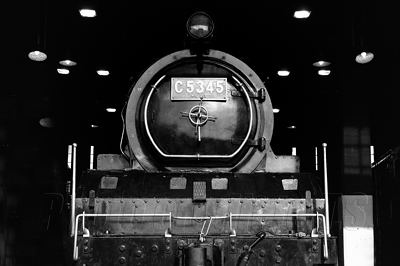
C53 No.45
At Umekoji Museum during 1972.
Japanese
|
1928 - 1950 A three-cylinder large Tender-Engine for arterial railroad express passenger trains. |

C53 No.45 At Umekoji Museum during 1972. |
|
After C51 made its appearance, passenger cars increased in weight due to the fact that steel replaced wooden construction.
Accordingly, arterial line passenger trains needed a more powerful engine. C53 was designed from such a background.
The new model designs reflected the trend of three cylinder engines being used in Europe and the US.
Previously the C52 already exhibited that trend in 1925, but were imported from the US ALCO (American Locomotive Co.)
The first C53 was manufactured at the Kisha Seizo Co. it's manufactured number was 996. She was retired during November 1948, and was scrapped.
A total of 97 C53s were manufactured during 1928 to 1930 entirely in Japan. It continued that service until the appearance of the C59 in the year of 1941 and was replaced on the main lines of Tokaido and Sanyo. C53 was a symbolic figure for Japanese arterial railroad express before WW2. One of the C53s, C53_43 was tested as a streamline design during 1934. This test remodeling gave heir to the next streamline model C55. During the war, the complicated three-cylinder engine C53 was given the cold-shoulder because of short material supply and poor expert technology. C53s saw limited service after the war due to dilapidation and only half continued in service. As a symbolic figure, it was a wreck of its former self as an express engine. Retirement was decided for all C53s when class C62 arrived in 1947. All engines were retired during 1948-1950 in a mere 3 years. C53 had a 20 year shortened life expectancy. Their short-life primary reason was a three-cylinder maintenance problem. A Japanese well-known railroad engineer Mr. Hiroshi Kubota mentioned that, "If C53 was a two cylinder model, they would have survived until 1956's Tokaido line electrification, and after the war made the C59 might not have appeared..... " And as a second reason, C53 was not able to be turned over to other main lines except Tokaido and Sanyo arterious lines because of their too heavy TAL (Tons Axle Load). All engines were retired on the Tokaido and Sanyo line's depot as a follows : Tokaido line -> Shizuoka 10, Hamamatsu 19, Nagoya 2, Ogaki 8, Maibara 5, Umekoji (Kyoto) 16 and Miyahara (Osaka) 10. Sanyo line -> Himeji 7, Hiroshima 11 and Shimonoseki 9. All C53s were scrapped up to 1950, with the exception of two engines. These two engines remained because of teaching purposes in railroad schools. One was C53_57, C53_57 was deregistered on the 24th of Jun 1950 at Ogaki depot, and she was preserved at the JNR Hamamatsu works. However, unfortunately, she was later scrapped around 1964. Another preserved C53 was No.45. C53_45 has been on exhibit at Umekoji Museum. Consult please C53_45's page for more information. |
| Primary ran line in last 10 years |
Tokaido, Sanyo line
| Last line/depot and year |
Tokaido, Sanyo line / Umekoji,
Hamamatu depot. 1950
| Restored engine (2017) |
none
| Preserved engine (2017) |
1 (No.45)
| |
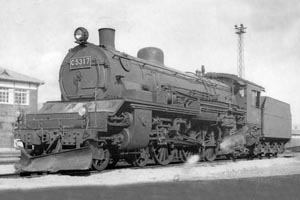
|
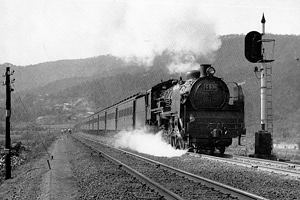
|
|
C53_17, Miyahara depot During Jan 1936. (Photo credit to K.Nishio). |
C53_1 betweent Kyoto and Yamashina on the Tokaido line. Oct 1935. (Photo credit to K.Nishio). |
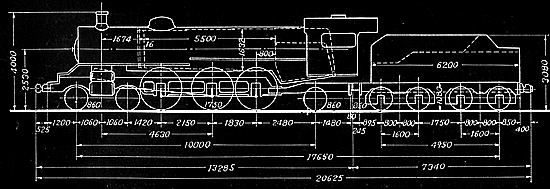
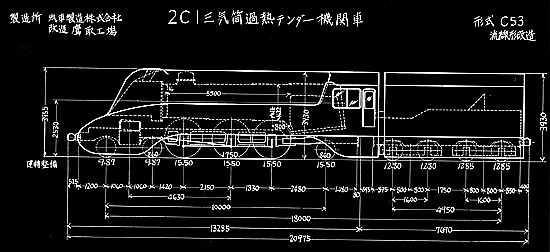
| Configuration | 4-6-2 | Dimensions Length (mm) | 20625 |
| Engine Weight (Operating tons) | 81.0 | Driver size (mm diameter) | 1750 |
| Boiler pressure (Kg/cm2) | 14.0 | Max Tractive effort (tons) | 11.6 |
| Driver Max Power (PS) | 1250 | Max Speed (km/h) | 100 |
| Manufactured years | 1928-1930 | Total production | 97 |
| Gauge | 3ft 6in (1067mm) |
Introduction |
Go to Top |